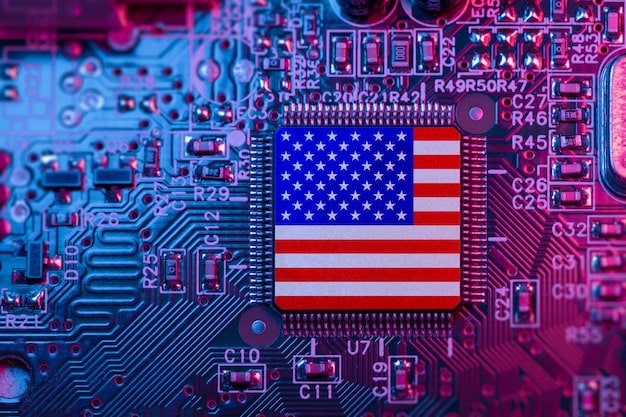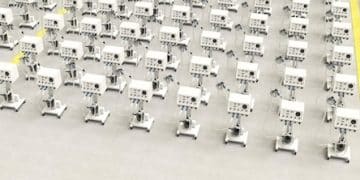CHIPS Act Impact: AI Hardware Research in the US (3-Month Update)

The Impact of the CHIPS and Science Act on AI Hardware Research in the US: A 3-Month Update reveals early progress in bolstering domestic semiconductor manufacturing and AI innovation, with significant investments and strategic partnerships beginning to shape the future of AI hardware development.
The **Impact of the CHIPS and Science Act on AI Hardware Research in the US: A 3-Month Update** provides a crucial snapshot into the early effects of this landmark legislation on the nation’s AI ecosystem. As the US navigates a rapidly evolving technological landscape, understanding the initial outcomes of this act is paramount.
Decoding the CHIPS and Science Act: A Quick Recap
The CHIPS and Science Act, signed into law with bipartisan support, aims to revitalize the US semiconductor industry and boost scientific research and development. It includes substantial funding for domestic chip manufacturing, research in advanced technologies, and workforce development programs.
Key Provisions for AI Hardware Research
A significant portion of the act is dedicated to fostering innovation in AI hardware. This includes funding for research grants, tax incentives for companies investing in semiconductor manufacturing, and initiatives to attract and train skilled workers in the field.
Why This Act Matters for the US
The CHIPS Act is crucial for several reasons. It seeks to reduce reliance on foreign chip manufacturers, enhance national security, and ensure US leadership in the global AI race. By incentivizing domestic production and innovation, the act aims to create a more resilient and competitive AI ecosystem.
- Reducing Foreign Dependence: Aims to decrease reliance on overseas chip suppliers.
- Boosting National Security: Strengthens domestic production to safeguard against supply chain disruptions.
- Driving Innovation: Encourages cutting-edge research and development in AI hardware.
- Creating Jobs: Supports the growth of high-tech manufacturing jobs in the US.
In summary, the CHIPS and Science Act is a comprehensive effort to secure America’s position as a leader in AI hardware research and development by addressing critical vulnerabilities and fostering domestic growth.
Initial Investments and Projects Kickstarted
Within the first three months of the CHIPS Act implementation, several investments and projects have been initiated, signaling the intent to accelerate AI hardware research. These early activities provide a foundation for future advancements and demonstrate a commitment to the act’s goals.
Semiconductor Manufacturing Incentives Rollout
The Department of Commerce has begun rolling out incentives for semiconductor manufacturers to build or expand facilities in the US. These incentives are designed to attract major players in the industry and encourage them to invest in domestic production capabilities.
Research Grants and Partnerships Launched
Funding opportunities for AI hardware research have been announced, leading to new partnerships between universities, research institutions, and private companies. These collaborations aim to drive innovation in areas such as neuromorphic computing, advanced packaging, and energy-efficient AI chips.

- Intel’s Expansion Plans: Intel has announced significant investments in expanding its US manufacturing footprint.
- TSMC’s Arizona Fab: Progress continues on TSMC’s advanced semiconductor fabrication plant in Arizona.
- Research Collaborations: Partnerships are forming to explore next-generation AI hardware architectures.
- Funding for Startups: Emerging companies are receiving grants to develop innovative AI chip technologies.
Overall, the initial investments and projects undertaken within the first three months of the CHIPS Act highlight a proactive approach to strengthening the US AI hardware landscape.
Challenges Encountered in Early Implementation
While the CHIPS Act has generated enthusiasm and momentum, the initial implementation has also presented several challenges. These hurdles need to be addressed to ensure the act’s long-term success and its impact on AI hardware research.
Supply Chain Bottlenecks Persist
Despite efforts to boost domestic production, global supply chain disruptions continue to pose challenges. Access to critical materials and components remains a concern, potentially slowing down the pace of AI hardware development.
Workforce Development Gaps
A shortage of skilled workers in the semiconductor industry is another significant obstacle. Attracting and training a workforce capable of designing, manufacturing, and maintaining advanced AI hardware is essential for achieving the act’s objectives.
Navigating Regulatory Hurdles
Companies seeking to access CHIPS Act funding and incentives face a complex regulatory landscape. Streamlining the application process and providing clear guidelines are crucial for encouraging widespread participation.
- Material Shortages: Difficulty in obtaining key components for chip manufacturing.
- Skills Gap: Lack of qualified personnel to support the growing semiconductor industry.
- Bureaucratic Delays: Complex application processes slowing down funding disbursement.
- Geopolitical Uncertainties: Ongoing trade tensions impacting the global chip market.
In conclusion, addressing these early implementation challenges is vital for maximizing the impact of the CHIPS and Science Act on AI hardware research and ensuring the US maintains a competitive edge in this critical field.
The Role of Academia and Research Institutions
Academia and research institutions play a crucial role in advancing AI hardware research. They serve as incubators for innovative ideas, train future generations of scientists and engineers, and collaborate with industry partners to translate research into real-world applications.
University Research Programs Expanded
Universities across the US are expanding their research programs in AI hardware, focusing on areas such as neuromorphic computing, quantum computing, and energy-efficient chip design. These programs receive funding from various sources, including the CHIPS Act, government agencies, and private companies.
Collaboration with Industry Partners
Research institutions are increasingly collaborating with industry partners to accelerate technology transfer and commercialization. These partnerships involve joint research projects, technology licensing agreements, and the creation of spin-off companies.

- Stanford’s AI Hardware Center: Leading research in energy-efficient AI chips.
- MIT’s Microsystems Technology Laboratories: Pioneering advancements in nanotechnology for AI.
- UC Berkeley’s RISC-V Initiative: Developing open-source hardware architectures for AI.
- Georgia Tech’s Center for Brain-like Computing: Exploring neuromorphic computing approaches.
In short, academia and research institutions are essential drivers of AI hardware innovation, contributing expertise, talent, and cutting-edge research that propels the field forward.
Impact on Emerging AI Applications
The advancements in AI hardware driven by the CHIPS Act have the potential to transform various emerging AI applications. These include autonomous vehicles, healthcare, cybersecurity, and advanced manufacturing, unlocking new possibilities and creating significant societal benefits.
Autonomous Vehicles
AI-powered autonomous vehicles require high-performance, energy-efficient hardware to process sensor data and make real-time decisions. The CHIPS Act can accelerate the development of specialized AI chips for autonomous driving, enabling safer and more reliable self-driving cars.
Healthcare Innovations
AI is revolutionizing healthcare through applications such as medical imaging, drug discovery, and personalized medicine. Advanced AI hardware can enhance the accuracy and efficiency of these applications, leading to better patient outcomes and reduced healthcare costs.
Cybersecurity Enhancements
AI algorithms can be used to detect and prevent cyberattacks, but they require powerful hardware to analyze large volumes of data in real time. The CHIPS Act can support the development of specialized AI chips for cybersecurity, improving the nation’s defenses against cyber threats.
- Self-Driving Cars: Enabling real-time processing of sensor data for autonomous navigation.
- Medical Diagnostics: Improving the accuracy and speed of disease detection.
- Fraud Detection: Enhancing the ability to identify and prevent fraudulent transactions.
- Robotics: Creating more intelligent and adaptable robots for various industries.
To summarize, the impact of the CHIPS and Science Act on AI hardware research is poised to unlock transformative advancements across a wide range of emerging AI applications, driving innovation and creating new opportunities for economic growth and societal progress.
Future Outlook and Key Milestones to Watch
Looking ahead, the success of the CHIPS Act will depend on achieving key milestones and addressing ongoing challenges. Several factors will shape the future of AI hardware research in the US, including continued investment, strategic partnerships, and workforce development efforts.
Continued Government Support
Sustained government funding and policy support are essential for maintaining the momentum of the CHIPS Act. This includes ongoing incentives for semiconductor manufacturing, research grants for AI hardware innovation, and initiatives to promote workforce development.
Strategic Industry Collaborations
Collaboration between government, industry, and academia will be crucial for accelerating the development and deployment of advanced AI hardware technologies. Strategic partnerships can leverage the strengths of each sector to drive innovation and create a more competitive AI ecosystem.
Workforce Development Initiatives
Investing in workforce development programs is essential for ensuring that the US has a skilled workforce capable of supporting the growing semiconductor industry. This includes training programs, apprenticeships, and educational initiatives focused on AI hardware design, manufacturing, and maintenance.
- New Fab Construction: Monitoring the progress of new semiconductor fabrication plants in the US.
- Research Breakthroughs: Tracking advancements in neuromorphic computing and other AI hardware technologies.
- Job Creation: Measuring the number of high-tech jobs created as a result of the CHIPS Act.
- Global Competitiveness: Assessing the US’s position in the global AI hardware market.
In conclusion, the future outlook for AI hardware research in the US is promising, but it requires continued commitment, strategic collaboration, and a focus on addressing key challenges to ensure that the CHIPS and Science Act achieves its goals and fosters a thriving AI ecosystem.
| Key Point | Brief Description |
|---|---|
| 💰 Funding Boost | CHIPS Act allocates billions to boost domestic chip manufacturing. |
| 🤝 Strategic Alliances | Academia, industry, and government unite for innovation. |
| 🚀 Tech Advancements | Focus on neuromorphic computing and energy-efficient AI. |
| 🏢 Job Growth | Act aims to create numerous high-tech jobs in the US. |
Frequently Asked Questions (FAQ)
▼
The Act primarily aims to bolster the US semiconductor industry by providing funding for domestic manufacturing and research to reduce reliance on foreign suppliers.
▼
The Act provides funding for research grants, tax incentives for companies, and initiatives to train skilled workers, fostering innovation in AI hardware development.
▼
Early challenges include supply chain bottlenecks, workforce development gaps, and navigating complex regulatory hurdles to access funding and incentives.
▼
Universities are expanding AI hardware research, collaborating with industry partners, and training scientists to accelerate technology transfer.
▼
Expected outcomes include advancements in AI applications such as autonomous vehicles, enhanced healthcare diagnostics, and cybersecurity systems due to AI hardware advancements.
Conclusion
In conclusion, the first three months The **Impact of the CHIPS and Science Act on AI Hardware Research in the US: A 3-Month Update** have laid the groundwork for a revitalized US semiconductor industry and accelerated AI innovation. By addressing supply chain vulnerabilities, fostering strategic partnerships, and supporting workforce development, the act aims to secure America’s position as a global leader in AI technology.





